Synth Sessions: A Beginner's Guide to Our Favorite Electronic Instruments
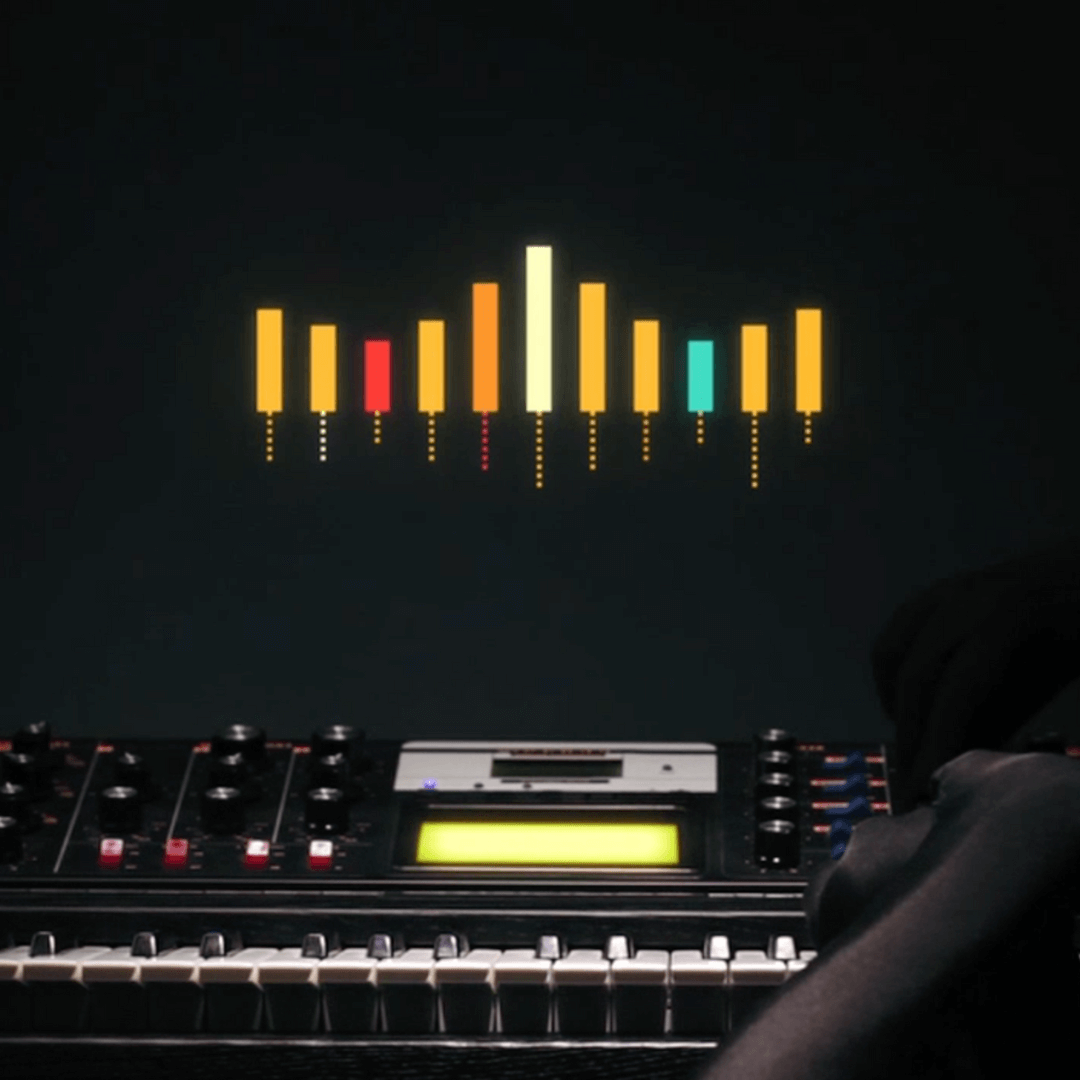
What exactly is a synthesizer, and how did they become so omnipresent in music?
Let’s talk about synths, baby!
Introduction
When musicians say the word synthesizer, what do you picture? Is it bleep-bloopy machines swimming in a sea of cables, making glitchy electronic music? Or do you happen to imagine the lead melody of a pop song like Blinding Lights by The Weeknd or the intro to an electronic song like Strangers by Kenya Grace? The thing is, almost all your favorite songs use synths! They're everywhere: in Espresso by Sabrina Carpenter, in the attack sounds in Fortnite, and in Hans Zimmer's Interstellar soundtrack.
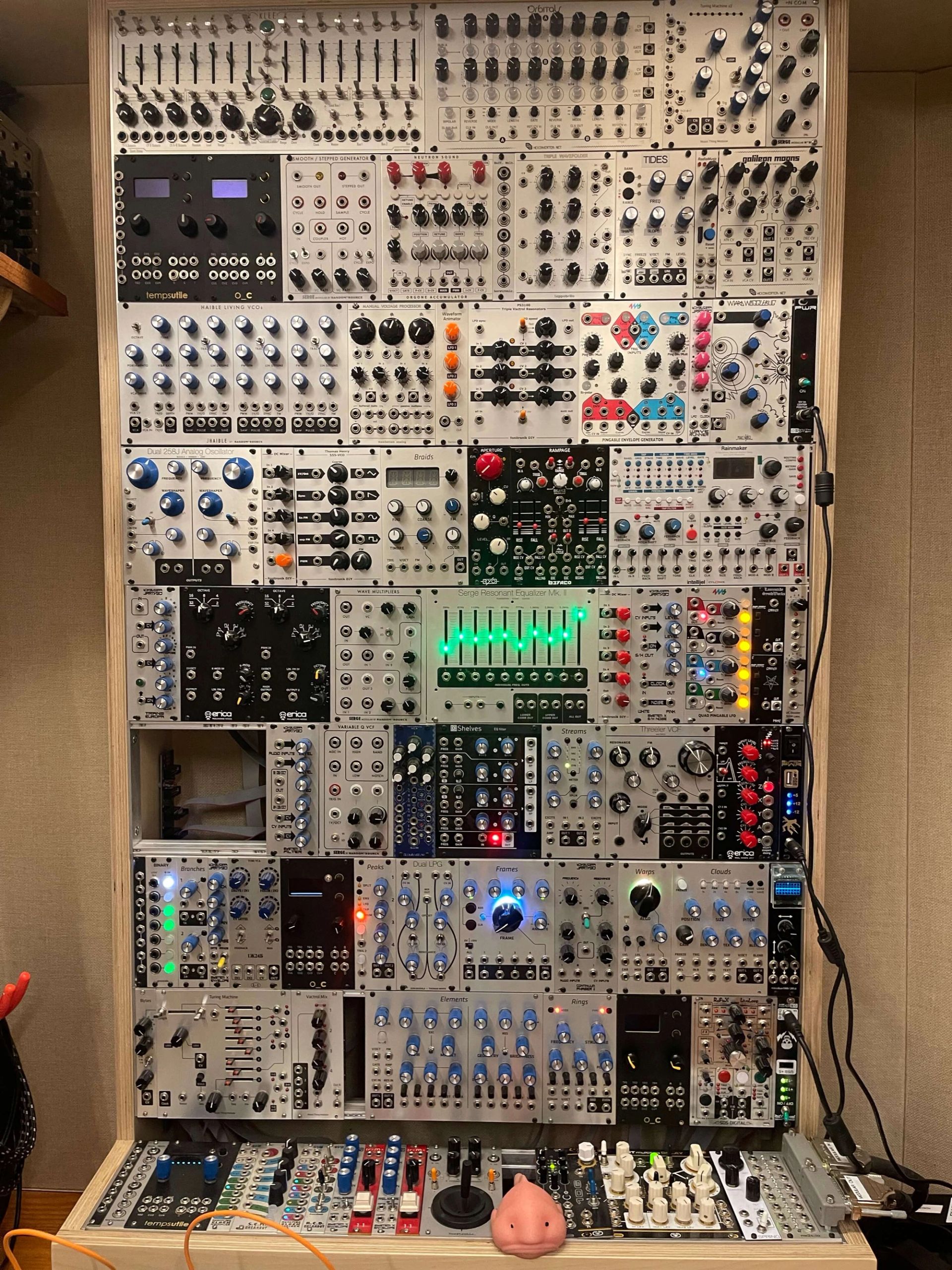
A modular synth rack at Antfood's office in Brooklyn
What on Earth is a Synthesizer?
To synthesize is to create by combining different elements. In audio, synthesis is creating sounds from scratch using basic building blocks: sound waves (such as sine waves and triangle waves), filters (devices that boost or cut certain frequencies in the sound), modulators (devices that change sound signals, like Low Frequency Oscillators or Envelopes, which control how a sound changes over time), and effects (like delays, reverbs, and distortions, which change the character of the sound).
A sine wave is a periodic wave that represents a single frequency with no harmonics. It’s considered an acoustically pure tone. All signals can be decomposed into a sum of sine waves.
Think of it like cooking. You could grab a pre-cooked meal from the store, or you could start with basic ingredients: tomatoes, eggs, turmeric, olive oil. Then, using different cooking techniques - chopping, mixing, and deep-frying - you can transform those simple ingredients into something completely new.
Now, instead of cooking ingredients, imagine you're working with sounds. Instead of grabbing a pre-recorded piano sound, you start with basic sound waves (like sine waves and sawtooth waves - think of these as your turmeric and tomatoes), then, using various tools (filters and effects - your cooking techniques), you shape and combine them to create beautiful sounds!
That's the magic of synthesizers: unlimited possibilities from different combinations of signal generators, signal processors, and signal modulators. And just like cooking, once you understand the basics, you can experiment endlessly.
A Brief History of Synths
Before we get into the sonic exploration, let’s understand where synths come from. Here’s a really informative video by Soundfly if you'd like a quick summary!
The Predecessors to Modern Synths (1920s-1950s)
In 1928, a Russian inventor named Lev Termen (known in the West as Leon Theremin) created a musical instrument that seemed like magic: the theremin.
The theremin has two electronic oscillators (an oscillator is an electronic generator that creates a repeating periodic waveform). One of these oscillators stays at a fixed frequency and one changes. It also has a mixer and two metal antennae. Each antenna works like part of a capacitor, an electronic device that stores energy. When you move your hand near one of the antennas, it changes the electrical field, which affects the sound. The signals from the two oscillators are combined (by a process called heterodyning) to create the theremin’s famously eerie, voice-like quality.
In fact, the theremin is the only instrument you play without touching it! Check out this video of Clara Rockmore, a Theremin virtuoso, performing the instrument.
The Theremin didn't just make cool, cello-like, warbly, electronic sounds. It made people realize that music didn't have to come from traditional instruments. Before this, if you wanted music, you needed strings, wood, metal, or air moving through pipes. The Theremin proved you could make beautiful, expressive music with nothing but electricity and hand movements. Here’s the link to a playlist of famous songs made with theremins!
Suddenly, inventors and musicians started asking: "What else is possible?" The Theremin planted a seed in people's minds that would grow into the entire electronic music revolution. It showed that the future of music might not be limited by the physical world at all. Friedrich Trautwein invented the Trautonium in the 1930s. With the Trautonium, you pressed on a wire to control pitch. These early instruments proved something revolutionary: you could make music with electricity, not just acoustic instruments. Each one made the idea of electronic music a little less crazy and a little more inevitable.
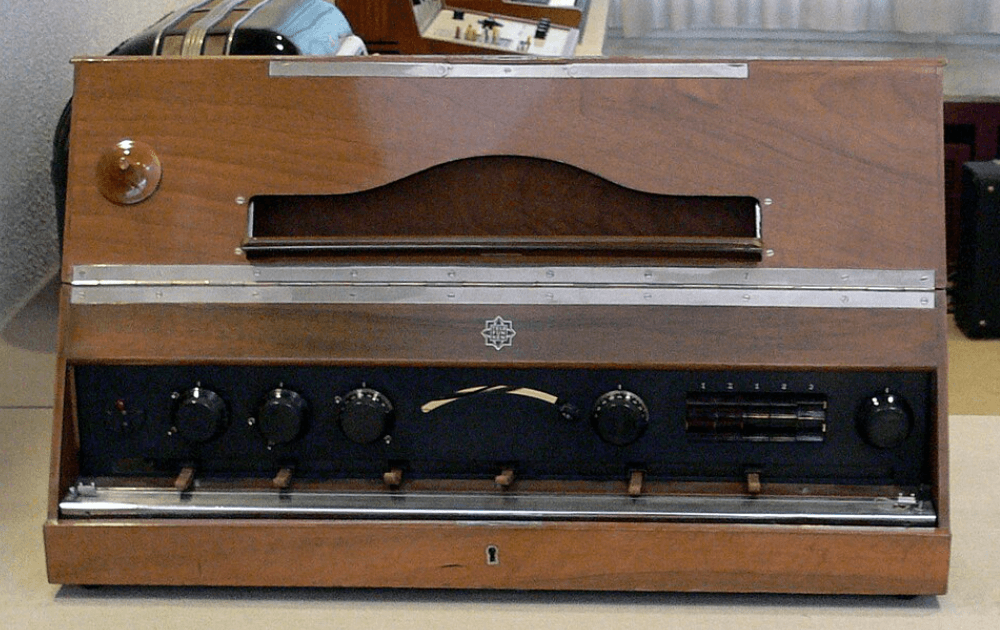
Telefunken Volkstrautonium, 1933 (Telefunken Trautonium Ela T 42 (1933–35)), a production version of the Trautonium co-developed by Telefunken, Friedrich Trautwein, and Oskar Sala from 1931 onwards.
The First Modern Synthesizers (1950s-1970s)
The first true synthesizer was the RCA Mark I in 1955. But calling it user-friendly would be generous. This synth was room-sized and had no keyboard. Musicians programmed it with punched paper tape like an old computer, spending hours just to get a single note right. Imagine wanting to play a simple C major scale. First, you'd have to calculate the exact frequency for each note, then punch holes in a paper tape in a specific pattern to tell the machine what frequencies to produce, for how long, and how loud. If you made one tiny mistake in your calculations or punched one hole in the wrong spot, you'd have to start completely over. A melody that would take 10 seconds to play on a piano might take an entire day to program correctly. But it was revolutionary; it could create sounds that acoustic instruments simply couldn't make. Even if it took forever, the results were unlike anything anyone had ever heard.
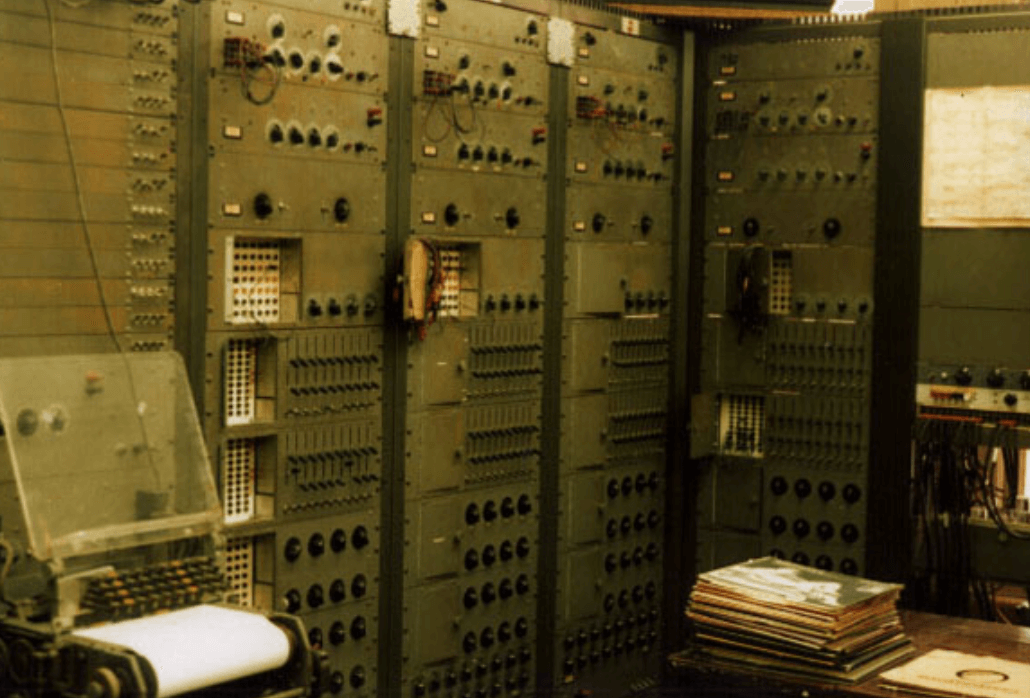
RCA Mark I
East Coast vs. West Coast Synthesis
The real revolution came in the 1960s when brilliant minds on opposite coasts of the USA started making synthesizers that the average person could use. On the East Coast, Robert Moog and Wendy Carlos were developing synthesizers with keyboards and patch cables that felt familiar to traditional musicians. Moog’s approach was intuitive - if you could play piano, you could figure out a Moog (Here’s Wendy Carlos demonstrating how to use the original Moog). Meanwhile, on the West Coast, Don Buchla was taking a completely different path with experimental systems like the Buchla Music Easel. Where Moog gave you a keyboard, Buchla gave you touch plates and sequencers (a sequencer is a device that plays back signals in patterns - this could be pitches, samples. or midi events). Where Moog made sounds that felt musical, Buchla pushed you into sonic territories that didn't even have names yet. Buchla's instruments weren't trying to replace pianos - they were trying to replace the entire concept of how we think about making music. Here’s a cool video demonstrating a modern Buchla Easel.
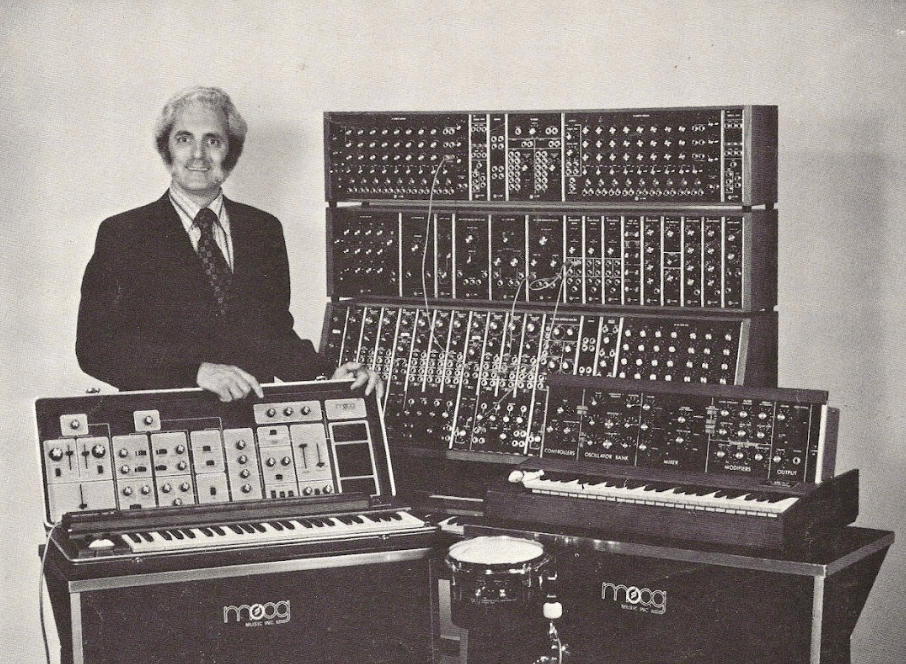
Robert Arthur Moog 1934 – 2005
But the game-changer was Moog's Minimoog in 1970 - the first truly portable synthesizer that any musician could afford. Before the Minimoog, electronic music was limited to wealthy universities and big record labels with massive budgets. Suddenly, a working musician could walk into a music store, buy a synthesizer, and take it home the same day. This meant that for the first time, creative people everywhere could access sounds that previously only existed in expensive laboratories.
A video of me playing a little melody while messing with the LFO rate modulating the filter of a Minimoog Voyager at Antfood’s Studio B.
Artists like Keith Emerson were suddenly creating sounds no one had heard before, and other musicians could actually buy the same tools and experiment themselves. Music would never be the same.
Types of Synths
Software Synths
These are software synths you can download on your computer or phone and use in a DAW (Digital Audio Workstation - think Garageband, Logic ProX, Pro Tools, or Ableton Live). Popular examples include Serum, Pigments, Massive, and Omnisphere. They offer incredible value and flexibility, you play them using MIDI notes (Musical Instrument Digital Interface - the digital standard that allows instruments and computers to communicate with each other. MIDI keyboards are the keyboards you use to play/trigger your software synths), so you can change the velocity, pitch, and rhythm of the sounds. You're only limited by your computer's processing power. There are tons of free software synths available if you’re looking to get started (They’re hyperlinked in the Next Steps section of this article).
Hardware Synths
These are physical electronic synthesizers with oscillators, filters, and other modules that generate and manipulate sound. They range from affordable options like the Korg Volca series to classic recreations like the Moog Subsequent 37. Hardware synths often have a more natural feel and each one has a unique colour. Plus, there's something really satisfying and fun about experimenting with synths, turning real knobs and automating parameters by hand as you play a sound.
A video of me experimenting with the modular rack at Antfood’s Studio D
4 common types of hardware synths are Analogue, Digital, Hybrid, and Modular.
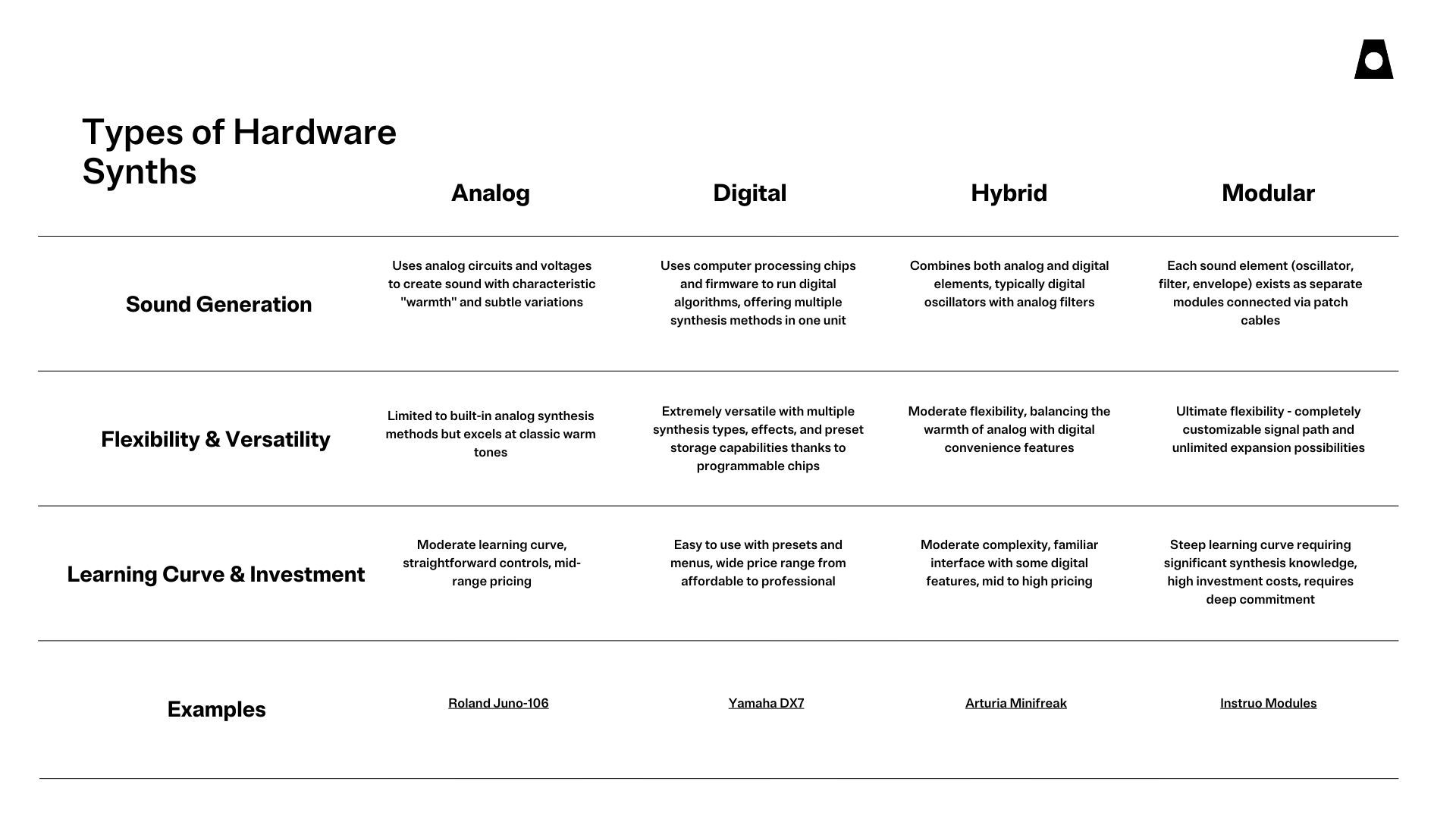
Why should you experiment with synths?
Here's the best part - synthesizers are more accessible than ever. You can download powerful software synths for free, experiment with browser-based synths, or start with affordable hardware.
But why should you care? Because learning synthesis teaches you about sound design and frequency relationships, giving you tools to create unique sounds that set your music apart. Whether you're a bedroom producer crafting beats on your laptop, a singer-songwriter looking to add atmospheric textures to your music, or you’re a video game sound designer, synthesizers offer endless possibilities as a tool for creative expression.
Plus, understanding synths helps you understand modern music. Every time you hear a pop song, film score, or video game soundtrack, you're hearing the descendants of those early electronic pioneers.
Every musician who picks up a guitar is working with an instrument that's been around for centuries. The possibilities have been explored pretty thoroughly. But with synthesizers? You're working with instruments that are constantly evolving, where new sounds and techniques are being discovered every day. You could literally create a sound that no human has ever heard before.
Next Steps
Here’s how you can get started on your synth journey
- Start free: Download a free software synth or try browser-based options
- Watch YouTube tutorials: Some of my favourite synth / sound design YouTubers are Andrew Huang for synth tutorials, modular synth intros and sample battles, Jabeau for Ableton synth sound design, Sofia Wylie for new synth introductions and music production tutorials and Rachel K Collier for synth walkthroughs
- Experiment: Don't worry about making "good" sounds at first - just explore, turn knobs, press buttons and see what happens. The coolest sounds are usually happy accidents!
- Listen and recreate: Try to identify synth sounds in your favorite songs and try to recreate them!
Conclusion
Synths revolutionised the audio world, democratising the music making process by giving everyone the opportunity to create from the comfort of their homes (hello, bedroom producers!). Every time you hear that characteristic synth sound, whether it's the haunting pad in a Blade Runner soundtrack or the punchy bass in a Drake song, you're listening to decades of innovation and creativity.
Synths are so much fun to explore and experiment with - you could spend hours twiddling knobs to create novel sounds that potentially no one has created before. We at Antfood are obsessed with synths and use them in so many projects - from creating Cello and electronic soundscapes in Netflix's enhanced "Tudum" to designing the Japanese City Pop sounds in the Nike x Nigo campaign. Synths are a gateway to infinite sonic possibilities, and now that you understand what they are and how they work, you're ready to start exploring these sonic playgrounds yourself.
Stay tuned for the next episode, where we’ll talk about waveforms and learn about synth modules and signal flow!